The Best Ventilation Hoods for Professional and High-Output Ranges for 2025
August 23rd, 2024 | 11 min. read
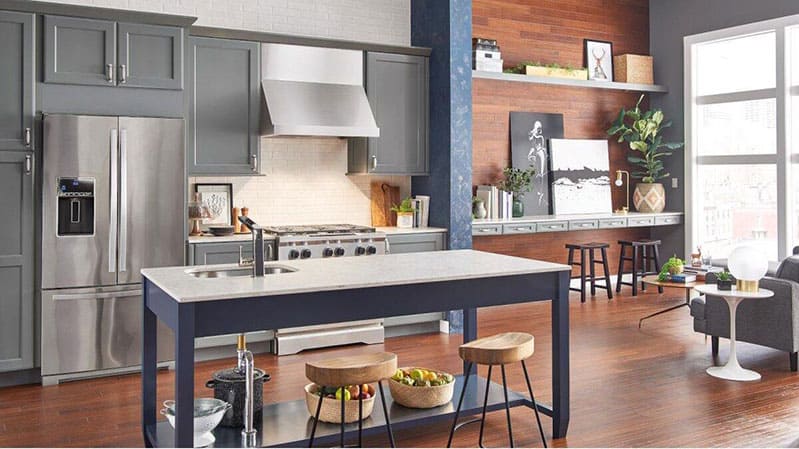
Properly venting your professional range is important—not just for keeping your kitchen odor-free, but for maintaining air quality and protecting your health.
In this article, you'll learn the top venting practices and the best vents to consider for your professional range.
As a bonus, you’ll also learn which vents to avoid—because, let’s face it, most vents can’t handle the power of today’s ranges.
Whether you cook with induction, regular gas, or electric burners, this article has you covered.
Let's get started.
The Problem With Ventilation
Most gas ranges are now 2-3 times more powerful than when I started at Yale in 1986.
Yet, many people either don’t vent their ranges or fail to vent them properly. This results in indoor air that’s far more polluted than the air outside.
As power increases, it's important to have better ventilation to manage the heat and fumes.
The Importance of Ventilation

Since you last purchased a professional range, burner outputs have steadily increased—from a maximum of 15,000 BTU (British Thermal Units) in 1990 to as much as 30,000 BTU today.
For example, Hestan offers a 30,000 BTU burner, BlueStar has multiple 25,000 BTU burners, and both SKS (Signature Kitchen Suite) and Monogram feature burners at 23,000 BTU.
Even Wolf and JennAir offer multiple 20,000 BTU burners.
To put this in perspective, a basic Whirlpool gas range now has two pro-rated burners at 15,000 BTU each—almost double the output of ranges back in 1986.
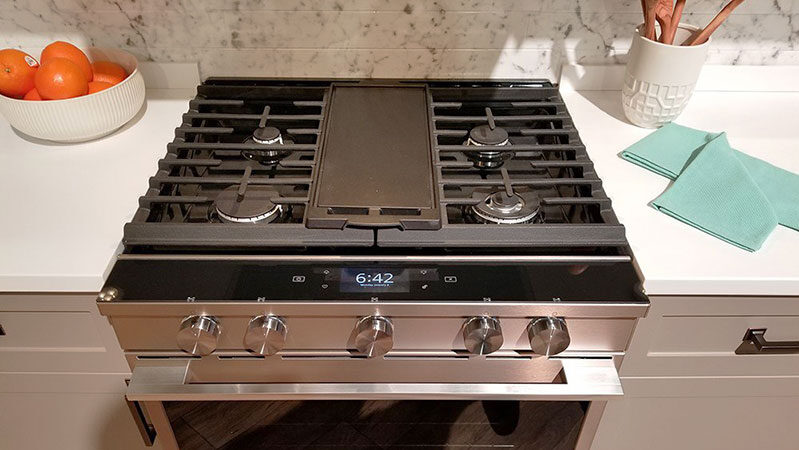
With this kind of heat, you need to vent all that smoke, grease, and odors outside.
Trust me, you don’t want your house perpetually smelling like your last dinner.
Potentially Toxic Compounds
But there are bigger problems than just smells.
During our research for webinars, podcasts, and articles, we came across some strange acronyms linked to the air you breathe in your home.
A quick Google search on whether gas ranges are harmful will reveal a slew of articles on how they might be hazardous to your health.
Gas ranges emit carbon dioxide, carbon monoxide, nitrous oxide, formaldehyde, and particulate matter.
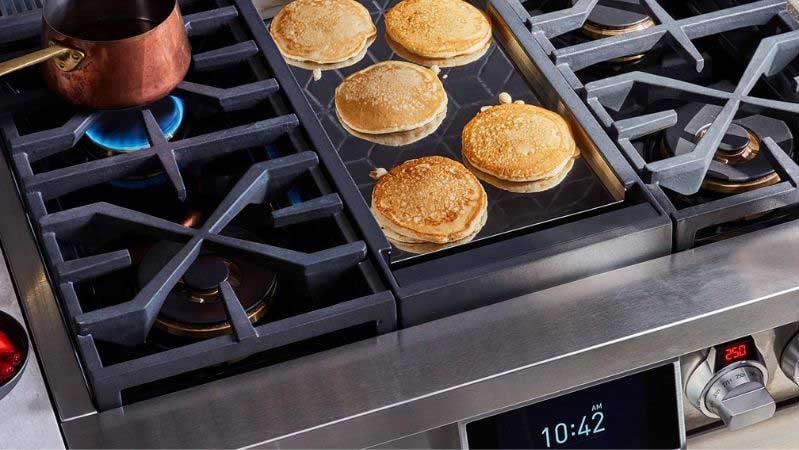
According to the Environmental Protection Agency (EPA), indoor air quality can be two to five times worse than outdoor air.
Here are some acronyms to keep in mind:
- IAQ (Indoor Air Quality): Refers to the safety of the air inside your home. For example, poor IAQ can result in breathing difficulties, headaches, or long-term health issues.
- IAP (Indoor Air Pollution): Indicates an excess of indoor pollutants.
- SBS (Sick Building Syndrome): Describes cases where people experience health and comfort issues linked to the time spent in a building, according to the EPA.
All these issues can be traced back to inadequate ventilation.
Unfortunately, even if you choose the right ventilation hood, you could still have inadequate ventilation if it's not properly installed.
That's why it's important to choose the right vent and ensure it's properly installed to help maintain better air quality in your home
How to Vent Your Professional Range (or Any Range)

Ventilation consists of four key components: CFM, capture area, duct run, and duct size.
1. CFM (Cubic Feet per Minute)
CFM measures how many cubic feet of air flow through the vent in one minute.
Range hood CFMs can range from 250 to 1500, which is the equivalent of moving 1500 cubes of air in a small room.
For perspective, a 600 CFM hood can remove the air in a 10' x 10' kitchen in about 10 minutes.
For grills, griddles, or woks, you should aim for 600 CFM for a 30-inch range and up to 1500 CFM for a 48 or 60-inch range.
The motor can be located inside or outside the hood, or inline in the duct.
2. Capture Area
Smoke isn’t expelled immediately after reaching your vent. This is where the capture area comes into play—and where many people make mistakes.
The worst vents have little to no capture area.
Even a 1500 CFM vent with a small capture area won’t work effectively for the front burners because the smoke will bypass the hood.
Smoke, heat, and grease need to be captured first, then vented.
That’s why you see massive hoods in restaurant kitchens—they capture everything.
Typically, you’ll use the power burners in the front of your range, which are around 22-23 inches deep.
You want a hood that’s at least 24-27 inches deep, 18 inches tall, and the same width as your stove. If it's on an island, add 6 inches to effectively capture the smoke.
3. Duct Run
Keep your duct run as simple as possible.
A straight-up duct run is ideal because it follows gravity—smoke rises anyway. A straight-back duct run on a wall works too.

Any transitions in the duct or longer runs reduce efficiency.
So, position your stove where it can be easily vented.
4. Duct Size
Duct size was a bigger issue years ago when contractors used dryer ducting.
Nowadays, most vents require a 6-10 inch round duct, with higher CFM hoods typically needing 8-10 inch round ducts.
Always double-check that your contractor is using the right duct size to keep your vent system working effectively.
How to Not Vent Your Professional Range
Unfortunately, many people unknowingly prioritize aesthetics over functionality.
Beautiful kitchens will only look good until you turn on the range.
Here are three common mistakes to avoid:
No Ventilation

Oddly enough, there are no laws against not having a range hood, though make-up air laws were enacted for homes that have vents.
In the example above, you’ve got roughly 130,000 BTUs plus a grill with no ventilation—so all that heat, smoke, and gas stays inside your home.
Remember, houses are built much tighter and more efficiently nowadays, so gas doesn’t escape through drafty windows like it did in years past.
Ceiling Blowers
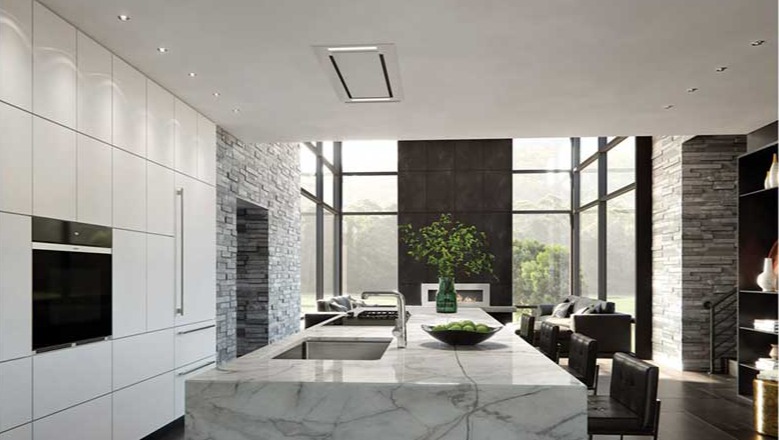
Ceiling blowers may have plenty of CFM, but they lack capture area.
To work properly, a ceiling blower should be installed 4-7 feet above the cooking surface.
However, many people install them on cathedral ceilings, which is a big mistake.
I once had a high-powered bath vent over a stove in my rental apartment. The ceiling around it became grimy and discolored over time.
Downdrafts
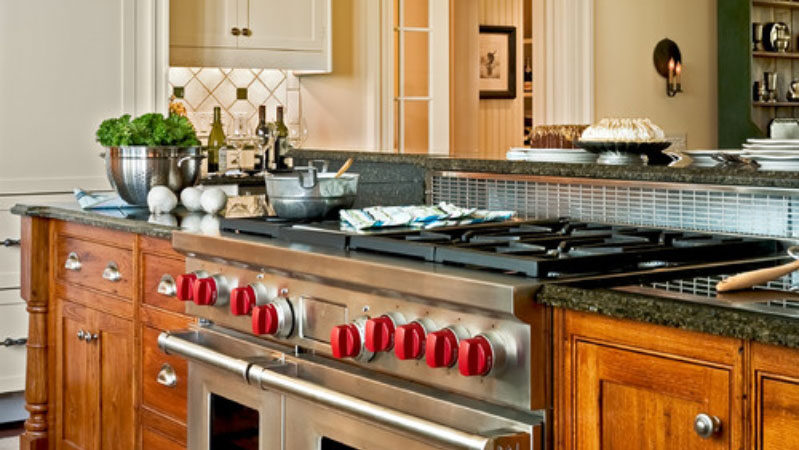
It’s hard to believe people still use downdrafts.
Imagine using your professional range and the smoke being pulled into a two-inch aperture, then reversed into a duct, and redirected with an elbow through a long duct run to the outside.
Downdrafting is the opposite of effective ventilation. It won’t work well, especially on the powerful front burners that get the most use.
Over-the-Range Microwaves

Over-the-range microwaves centralize your cooking but provide little ventilation at just 350 CFM.
On top of that, they’re usually only 16 inches deep, so they don’t cover the front burners.
I once had an over-the-range microwave in my apartment and watched whatever I cooked blow right past it.
Normal Undercabinet Hoods
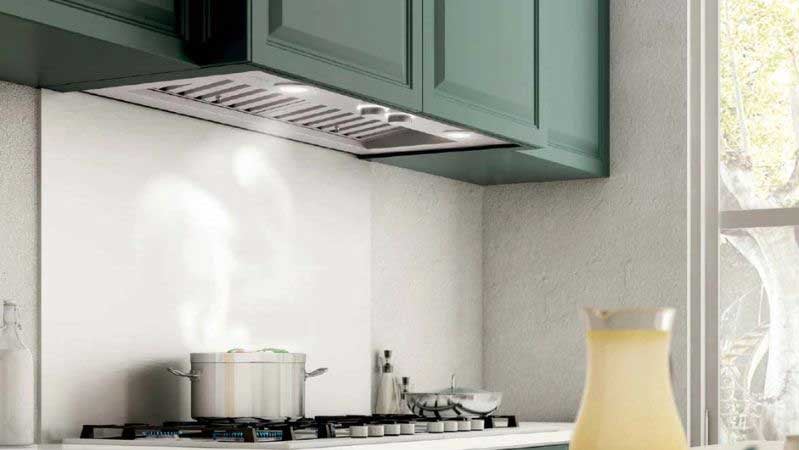
You can find undercabinet hoods that are 23 inches deep, but be careful—most are only 21 inches deep, and their capture area is lacking.
Larger 36-inch and 48-inch hoods might not provide enough height, especially with a griddle, grill, or wok burner.
Read More: Kitchen Hoods You Should Never Buy
Vented (Ducted) vs. Ventless (Ductless) Hoods
Ductless hoods recirculate air through a charcoal filter and exhaust it back into your room.
This means the heat and gases are essentially returned to your space.
You want your hood vented out of the house.
What CFM Should You Buy?
When I started, we were taught equations for calculating proper CFM. Thirty-eight years later, I’ve realized it depends on how you cook.
If you like to grill, griddle, wok, or stir fry, opt for a higher CFM hood.
A lower CFM in the 600s might be acceptable for a pro range with just burners.
Look for a minimum of 900-1200 CFM for a 36-inch range and 1200-1500 CFM for a 48 or 60-inch range.
The cost of a more powerful blower is minimal compared to the overall renovation.
How High Should You Hang a Hood?
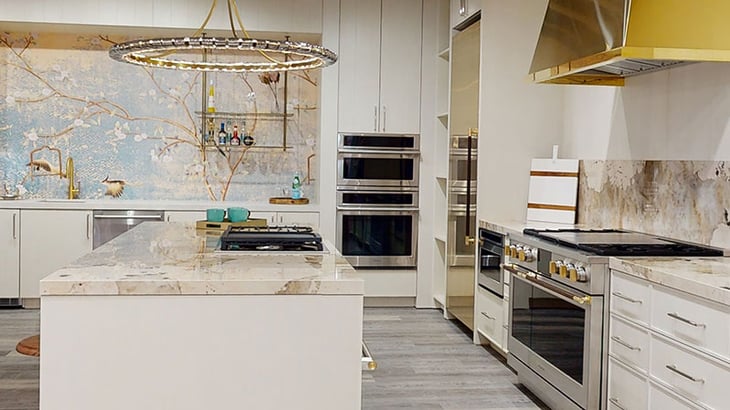
The height depends on the hood, but generally, it should be between 30-36 inches above the cooking surface.
If you have a high ceiling or a non-standard kitchen layout, consider consulting a professional installer to ensure optimal hood placement.
You can also read a whole article about hanging and installing a hood by clicking here.
Make-Up Air
It’s the law in Massachusetts, and we recommend it for any hood over a pro range.
Any hood over 400 CFM requires a fresh air return, either through your HVAC system or located 10 feet away from your range on the opposite side.
Make-up air is necessary.
You’re removing a small room of air from your house every minute, so it needs to be "made up."

Otherwise, that air will come from your furnace, attic, or garage, and you don’t want to breathe that.
In Summary
Proper ventilation isn't just a rule to follow—it's key to a safer and more comfortable home.
Pick the right hood and installation, and your professional range will work great without hurting your indoor air quality
Now, let's look at the best ventilation hoods for your professional range.
The Best Ventilation Hoods for Professional and High-Output Ranges for 2024
Below are the best ventilation hoods for professional ranges.
Whether you’re working with a high-output gas range or an induction cooktop, having the right hood makes all the difference in keeping your kitchen clean and your air quality safe.
Best Undercabinet Hood: Yale PUCCM630SS ($1,199) and PUCCM636SS ($1,299) for up to 1200 CFM

Undercabinet hoods are popular for their space-saving design, but they often struggle to handle the demands of high-output ranges.
Every undercabinet hood has challenges when it comes to exhausting a pro range.
Most undercabinet hoods aren’t deep enough to properly ventilate a pro range.
The powerful front burners on a pro range are about 21-23 inches deep, so smoke and grease can easily billow past most hoods—except for the Yale PUCCM630SS and PUCCM636SS.
Both hoods are 23 inches deep and offer a solid capacity of up to 1200 CFM.
This extra depth ensures that smoke and grease are captured more effectively, preventing them from escaping into your kitchen.
They’re designed to handle the demands of a pro-range burner.
However, if you have a grill or griddle, you'll want a deeper, more powerful hood.
Unlike most other undercabinet hoods, these models are quieter.
Plus, they come with a five-year warranty, and baffle filters are included.
For standard pro-range use, the Yale PUCCM630SS and PUCCM636SS provide excellent performance with reduced noise.
Best DIY Wood Hood Option: Yale PINTR146SS for up to 1200 CFM - $1,499

If you’re not a fan of stainless steel or color options, you can always go the DIY route.
For a custom wood hood, all you need are the mechanical components: a stainless liner for the inside of the hood, lights, filters, a control unit, and the blower.
Always ensure your hood is 24-27 inches deep with the appropriate CFM.
Most manufacturers offer hood inserts, but the Yale PINTR146SS provides flexibility with blower positioning—inside, outside, or inline.
You won’t need to replace the blower like you might with other brands.
This model also comes with baffle filters and a five-year warranty.
Best Looking: Thermador HPCN36WS for up to 1000 CFM - $3,099 + Blower
 The Europeans popularized the triangular hood vent, which features a sleek look with tapered sides.
The Europeans popularized the triangular hood vent, which features a sleek look with tapered sides.
However, most triangular hoods aren't designed for pro ranges because they’re only 21 inches deep.
Thermador is one of the few exceptions, offering a 24-inch depth.
While not as deep as some undercabinet or canopy hoods, the Thermador offers a sleek design without sacrificing too much performance.
With a maximum of 1000 CFM, the Thermador is best suited for ranges up to 36 inches.
Plus, it’s part of Thermador’s One, Two, Free program, which offers a $1,399 credit with qualifying purchases.
Best Capture and CFM: Wolf PW362718 for up to 1,500 CFM - $2,410 + Blower

Wolf's hood has the best capture area at 27 inches deep.
This extra depth ensures that smoke and grease are captured effectively before they can escape into your kitchen.
You can choose blowers with up to 1500 CFM for inside, inline, or outdoor use.
Like the Yale hoods, Wolf also features a heat sensor that automatically activates the hood when temperatures reach 200 degrees.
This feature automatically switches your hood to high when needed, preventing overheating and keeping the air clear without any effort on your part.
Best for Versatility: Yale PCHLV136SS for up to 1,200 CFM - $1,699

The Yale PCHLV136SS is a brand-new model with a triangular shape, similar to the Thermador.
It's 24 inches deep and designed specifically for use over a pro range.
While not as deep as some other models, it still offers solid coverage for your cooking surface.
This model offers quieter operation, better lighting, and the flexibility to place the blower wherever you prefer—inside, outside, or inline.
It also includes heat sensing and other advantages outlined earlier.
Best Value: Yale PWLCL148SS for up to 1200 CFM - $1,999

The Yale 48-inch Canopy Hood (PWLCL148SS) has been redesigned after four years and now includes features that enhance ventilation in your space.
With its 25-inch depth, it covers more of your range than the standard 24-inch models, ensuring better capture of smoke and grease.
This hood can be vented inline, outside, or internally with the same blower, so you don’t need to worry about choosing or changing blowers if your kitchen layout presents challenges.
Like all Yale hoods, it features "S-shaped" baffle filters designed to capture the maximum amount of grease and smoke.
The Heat Guard senses extreme temperatures and automatically adjusts the blower to high.
Plus, Yale hoods now feature HUSH sound suppression for 35% less noise.
The lighting is set at 3000 Kelvin with up to 1580 lumens on the larger size.
Why is 3000 Kelvin important?
On the Kelvin scale, 3000 is considered soft, flattering light—perfect for kitchens.
When we sold lighting, the best-recessed lights ranged from 2500 to 3000 Kelvin.
This hood will shine a ton of good-quality light.
Lastly, Yale hoods include an industry-best five-year warranty, giving you peace of mind that any issues with performance will be covered.
Best Color Option: BlueStar SC048MLPLTDCF for up to 1400 CFM - $10,685 + Blower

BlueStar offers unmatched customization with over 1,000 colors and ten trims to choose from.
It’s ideal if you want a custom range and range hood.
They can even match a nail polish color to a hood.
However, keep in mind that you’re paying $10,000 more for a custom color.
While pricey, the ability to match your range and hood to your exact specifications might be worth it for those looking for a truly unique kitchen.
Best to Customize: AGA AMCHD36-SS for up to 600 CFM - $3,849

If you have shorter ceilings—like in a garden apartment in the South End or anywhere in Boston—you may need a shorter hood.
AGA allows you to customize the height, as well as the color and other options.
How to Choose a Ventilation Hood
If you follow the rules, choosing a range hood is easy.
You want an 18-inch tall, 24-27-inch deep hood with the same width as your range, and six inches wider on an island.
You also want a reliable option, which can be challenging with so many no-name brands on the market.
Just make sure the components are solid.
Always look at all the components before you buy a range hood, especially the blower.
A hood can be purchased with the blower inside, usually up to 1200 CFM.
You can also buy the hood as a shell and get the blower separately, ranging from 600 to 1500 CFM.
Blowers can be placed inside the hood, outside your home, or in the duct.
I prefer the blower inside because it’s easier to fix.
You must allow access to an inline blower in case of repair.
Outside blowers are quieter, but you’ll still hear the rush of air.
They’re not that good-looking and are harder to repair in the winter.
Of course, with the new Yale hood we mentioned at the top of this article, you can install a blower in all three ways.
Read More: How to Choose the Best Kitchen Range and Range Hood
Best Ventilation Hoods for Pro Ranges: Key Takeaways
Buying the right ventilation will improve the indoor air quality of your home.
Remember to choose the right capture area and CFM and plan your duct accordingly.
Yale, Wolf, and Thermador are all solid options that will efficiently evacuate smoke, heat, and gases from your home.
You can also choose BlueStar for a custom color or integrate it with your cabinetry.
Additional Resources
Get the Yale Ventilation Buying Guide with features, specs, and inside tips for every brand and hood type. Well over 1 million people have read a Yale Guide.
Related Articles:
Why Should You Trust Us?
It seems that every appliance review has nothing but glowing comments about almost every product, yet you read customer reviews and they are almost universally bad.
We are here to fill in the disconnect. We'll give you the best features, and the drawbacks as well, including reliability based on over 37,000 calls performed by our service team just last year. Our goal is to give you ALL the information so you know what's right for you.
Please consider subscribing or adding to the conversation in the comments below. We appreciate you stopping by.
Steve Sheinkopf is the third-generation CEO of Yale Appliance and a lifelong Bostonian. He has over 38 years of experience in the appliance industry, and he is a trusted source of information for consumers on how to buy and repair appliances.
Steve has also been featured in numerous publications, including the
New York Times,
Consumer Reports,
The Boston Globe,
Bloomberg Radio, the
New York Post,
The Wall Street Journal, and
Entrepreneur, for his knowledge of how to buy appliances and appliance repair.
Steve is passionate about helping consumers find the best appliances for their needs, and he is always happy to answer questions and provide advice. He is a valuable resource for consumers who are looking for information on appliance buying, repair, and maintenance.
Despite being the worst goalie in history, Steve is a fan of the Bruins and college hockey, loves to read, and is a Peloton biker. The love of his life is his daughter, Sophie.
A Note About Pricing
Pricing on this blog is for reference only and may include time sensitive rebates. We make every attempt to provide accurate pricing at time of publishing. Please call the stores for most accurate price.
Topics:


